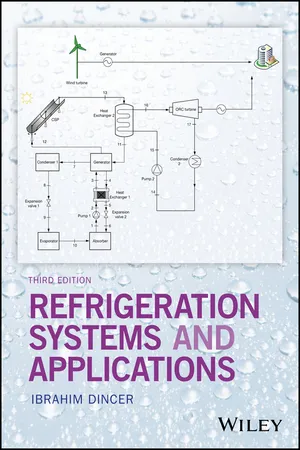
- English
- ePUB (mobile friendly)
- Available on iOS & Android
Refrigeration Systems and Applications
About This Book
The definitive text/reference for students, researchers and practicing engineers
This book provides comprehensive coverage on refrigeration systems and applications, ranging from the fundamental principles of thermodynamics to food cooling applications for a wide range of sectoral utilizations. Energy and exergy analyses as well as performance assessments through energy and exergy efficiencies and energetic and exergetic coefficients of performance are explored, and numerous analysis techniques, models, correlations and procedures are introduced with examples and case studies. There are specific sections allocated to environmental impact assessment and sustainable development studies. Also featured are discussions of important recent developments in the field, including those stemming from the author's pioneering research.
Refrigeration is a uniquely positioned multi-disciplinary field encompassing mechanical, chemical, industrial and food engineering, as well as chemistry. Its wide-ranging applications mean that the industry plays a key role in national and international economies. And it continues to be an area of active research, much of it focusing on making the technology as environmentally friendly and sustainable as possible without compromising cost efficiency and effectiveness.
This substantially updated and revised edition of the classic text/reference now features two new chapters devoted to renewable-energy-based integrated refrigeration systems and environmental impact/sustainability assessment. All examples and chapter-end problems have been updated as have conversion factors and the thermophysical properties of an array of materials.
- Provides a solid foundation in the fundamental principles and the practical applications of refrigeration technologies
- Examines fundamental aspects of thermodynamics, refrigerants, as well as energy and exergy analyses and energy and exergy based performance assessment criteria and approaches
- Introduces environmental impact assessment methods and sustainability evaluation of refrigeration systems and applications
- Covers basic and advanced (and hence integrated) refrigeration cycles and systems, as well as a range of novel applications
- Discusses crucial industrial, technical and operational problems, as well as new performance improvement techniques and tools for better design and analysis
- Features clear explanations, numerous chapter-end problems and worked-out examples
Refrigeration Systems and Applications, Third Edition is an indispensable working resource for researchers and practitioners in the areas of Refrigeration and Air Conditioning. It is also an ideal textbook for graduate and senior undergraduate students in mechanical, chemical, biochemical, industrial and food engineering disciplines.
Frequently asked questions
Information
Chapter 1
General Aspects of Thermodynamics
1.1 Introduction
Table of contents
- Cover
- Title Page
- Copyright
- Table of Contents
- Preface
- Acknowledgments
- Chapter 1: General Aspects of Thermodynamics
- Chapter 2: Refrigerants
- Chapter 3: Refrigeration System Components
- Chapter 4: Refrigeration Cycles and Systems
- Chapter 5: Advanced Refrigeration Cycles and Systems
- Chapter 6: Renewable Energy-based Integrated Refrigeration Systems
- Chapter 7: Heat Pipes
- Chapter 8: Food Refrigeration
- Chapter 9: Food Freezing
- Chapter 10: Environmental Impact and Sustainability Assessment of Refrigeration Systems
- Appendix A: Conversion Factors
- Appendix B: Thermophysical Properties
- Appendix C: Food Refrigeration Data
- Index
- End User License Agreement